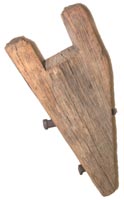

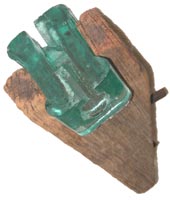
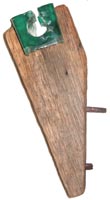
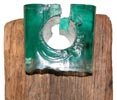
During the early years of line construction, the glass block was a popular form of insulator. While they were also placed in service in later years, their most widespread use in construction was in the 1846-1848 time period. They could be placed either in a crossarm, notched for the block to be dropped in place, or in a side bracket, shaped to receive the insulator. (Figure 2.) In some cases a notch was made at the top of a pole and the block inserted into the opening. In all three applications, a board was usually employed to form a roof over the insulator. Different sizes and variations of these insulators exist and the following is a study of them.
This type is represented by CD's 1000, 1002, 1003, 1004, and 1005. It appears that this is a better design, since the oblique opening would help to prevent the line wire from accidentally escaping, especially when side brackets were employed and the use of a board as a roof could not be placed in direct contact with the top of the insulator as was the case in applications using a crossarm. The earliest available documented use of this type insulator was on a line completed in December 1846 between Philadelphia and Pittsburgh, Pennsylvania.
In his book The Telegraph in America, James Reid described its use as follows: "The insulation was chiefly with square blocks of glass, flanged at either end and grooved to receive the wire. The upper edge of the groove was oblique, so as to retain the wire when once it entered. A wooden roof covered the glass." (p. )





This original bracket and scarce CD 1003 block were located around Medford, Oregon in 1978. The wood bracket is notched so as to accommodate the glass block. Two square nails are pounded through the bracket into a tree or pole. A flat board (which was not found with the bracket) is nailed into the top of the bracket, across the top of the insulator, forming a protective roof.
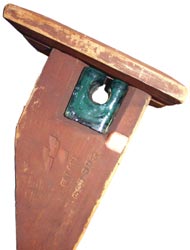
CD 1000 flanged block installed in complete bracket with roof.
Photo Copyright © 2000 Smithsonian Institution -
See Copyright notice
Unless otherwise noted, photos by Larry Novak or Bob Berry
These were also widely used by one, and possibly two of the competing companies constructing lines between Louisville, Kentucky, and New Orleans, Louisiana. Many of the CD 1000's and one CD 1002 were found in a wood box in an old building in Gallatin, Tennessee, which was on the route of the line. They have also been found in Alabama in the vicinity of another line constructed between Washington, D.C. and New Orleans in the late 1840's. One of the CD 1004's was found with the other blocks in Gallatin and another was dug near Louisville, Kentucky.


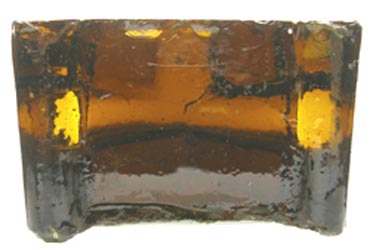

CD 1000 (above) is an early block style where the entrance to the channel moves from the left to the right.

CD 1002 (above left) is an early block style where the entrance to the channel moves from the right to the left.


SIDE VIEW FROM CJOW BLOCK INSERT
The CD 1003 (above right) is an early block style where the entrance to the channel moves from the left to the right. It has a more chunky profile than the CD 1000. The CD 1003 has a wire groove with the same diameter end to end, and a shallow coffin bottom base.
 SIDE VIEW FROM CJOW BLOCK INSERT
SIDE VIEW FROM CJOW BLOCK INSERT
CD 1004 (left) is an early block with a narrow and long profile where the entrance to the channel moves from the left to the right. It was adapted for use in a crossarm.



The last style of early block insulators is a straight channel, smaller profile insulator, the CD 1005.
UNASSIGNED CD CHARLIE IRONS
This Fishy Glass Block block was purchased by me at a Collectors' Show that was held on the East Coast. It had been spotted by another insulator collector, but he passed it by thinking that it might be a fake. The glass block had been to two other Shows before this one.
After purchasing the glass block, I asked the sellers where they had gotten it. I was told that it was just a piece of glass that was thrown aside on a pile of dirt near a hole where they had been digging in southeastern Pennsylvania in 2002. Being JUST a chunk of glass, the two bottle diggers were not interested in it. Their hole was about 35 feet deep, and that is the depth where they found the glass block.
The block sat on the pile of dirt for two days, with all the other broken bottles, etc., until a friend of the two bottle diggers told them that he thought it was an insulator.
It is important to note that on the back of this block there is an impression of a FISH with scales on it (very unusual).
This one-of-a-kind glass block now resides in the collection of Butch and Eloise Haltman in California.
KIDWELL PATTERN BLOCK
S.F. GLASS CO. BLOCK
(Fake)